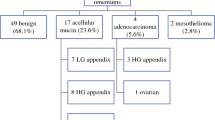Abstract
Background
We sought to assess the prognostic significance of chemotherapy effect on upper abdominal metastatic disease.
Methods
Retrospective chart reviews were carried out from 1997 to 2005 to identify ovarian cancer patients treated with neoadjuvant chemotherapy. Pathologic examinations of resected omental and ovarian tumors for the presence of chemotherapy effect were performed. Cox proportional hazard models were built to model time to progression and death by using predictor variables of age, tumor grade, amount and location of largest residual disease, and the presence of chemotherapy effects on resected tumors.
Results
Sixty-six patients with available slides and clinical information were identified. The presence of omental chemotherapy effects was observed in 58 patients (88%). Identified independent statistically significant predictors for progression-free survival included presence of omental chemotherapy effect (hazard ratio [HR], .38; 95% confidence interval [95% CI], .17–.89; P = .026) and suboptimal tumor residuals in upper abdominal location compared with pelvic location (HR, 2.41; 95% CI, 1.06–5.48; P = .035). The presence of omental chemotherapy effect was the only statistically significant predictor of disease specific survival (HR, .21; 95% CI, .068–.639; P = .006). The estimated median survival for the group with positive omental chemotherapy effect was 84.45 months (95% CI, 69.63–99.28). The corresponding statistic in patients with no observed response to chemotherapy was 31.15 months (95% CI, 21.84–40.47).
Conclusions
Upper abdominal disease location and its response to chemotherapy were independent prognostic factors for progression-free survival. Aggressive upper abdominal debulking procedures are recommended to improve oncologic outcomes.

Similar content being viewed by others
References
Barnholtz-Sloan JS, Schwartz AG, Qureshi F, et al. Ovarian cancer: changes in patterns at diagnosis and relative survival over the last three decades. Am J Obstet Gynecol 2003;189:1120–7
McGuire V, Jesser CA, Whittemore AS. Survival among US women with invasive epithelial ovarian cancer. Gynecol Oncol 2002;84:399–403
Ferrandina G, Legge F, Salutari V, et al. Impact of pattern of recurrence on clinical outcome of ovarian cancer patients: clinical considerations. Eur J Cancer 2006;42:2296–302
Aletti GD, Dowdy SC, Podratz KC, Cliby WA. Surgical treatment of diaphragm disease correlates with improved survival in optimally debulked advanced stage ovarian cancer. Gynecol Oncol 2006;100:283–7
Chi DS, Franklin CC, Levine DA, et al. Improved optimal cytoreduction rates for stages IIIC and IV epithelial ovarian, fallopian tube, and primary peritoneal cancer: a change in surgical approach. Gynecol Oncol 2004;94:650–4
Eisenkop SM, Spirtos NM, Friedman RL, et al. Relative influences of tumor volume before surgery and the cytoreductive outcome on survival for patients with advanced ovarian cancer: a prospective study. Gynecol Oncol 2003;90:390–6
Giannopoulos T, Butler-Manuel S, Taylor A, et al. Clinical outcomes of neoadjuvant chemotherapy and primary debulking surgery in advanced ovarian carcinoma. Eur J Gynaecol Oncol 2006;27:25–8
Hegazy MA, Hegazi RA, Elshafei MA, et al. Neoadjuvant chemotherapy versus primary surgery in advanced ovarian carcinoma. World J Surg Oncol 2005;31:57–9
Vergote I, De Wever I, Tjalma W, et al. Neoadjuvant chemotherapy or primary debulking surgery in advanced ovarian carcinoma: a retrospective analysis of 285 patients. Gynecol Oncol 1998;71:431–6
Eisenkop SM, Spirtos NM. Procedures required to accomplish complete cytoreduction of ovarian cancer: is there a correlation with “biological aggressiveness” and survival? Gynecol Oncol 2001;82:435–41
Sassen S, Schmalfeldt B, Avril N, et al. Histopathologic assessment of tumor regression after neoadjuvant chemotherapy in advanced-stage ovarian cancer. Hum Pathol 2007;38(6):926–34
Steed H, Oza AM, Murphy J, et al. A retrospective analysis of neoadjuvant platinum-based chemotherapy versus up-front surgery in advanced ovarian cancer. Int J Gynecol Cancer 2006;16(Suppl 1):47–53
Kapp KS, Kapp DS, Poschauko J, et al. The prognostic significance of peritoneal seeding and size of postsurgical residual in patients with stage III epithelial ovarian cancer treated with surgery, chemotherapy, and high-dose radiotherapy. Gynecol Oncol 1999;74:400–7
Eisenkop SM, Spirtos NM. What are the current surgical objectives, strategies, and technical capabilities of gynecologic oncologists treating advanced epithelial ovarian cancer? Gyn Oncol 2001;82:489–97
Author information
Authors and Affiliations
Corresponding author
Rights and permissions
About this article
Cite this article
Le, T., Williams, K., Senterman, M. et al. Omental Chemotherapy Effects as a Prognostic Factor in Ovarian Cancer Patients Treated With Neoadjuvant Chemotherapy and Delayed Primary Surgical Debulking. Ann Surg Oncol 14, 2649–2653 (2007). https://doi.org/10.1245/s10434-007-9460-2
Received:
Accepted:
Published:
Issue Date:
DOI: https://doi.org/10.1245/s10434-007-9460-2




